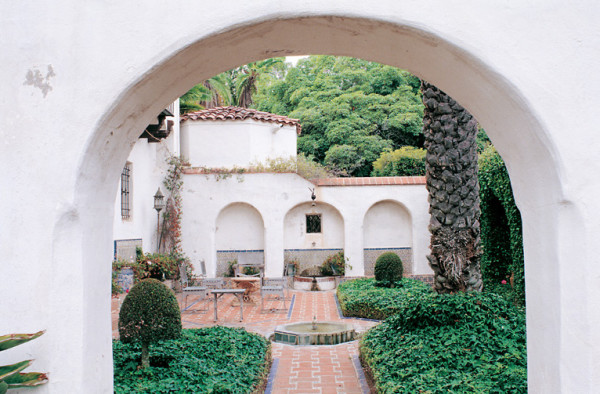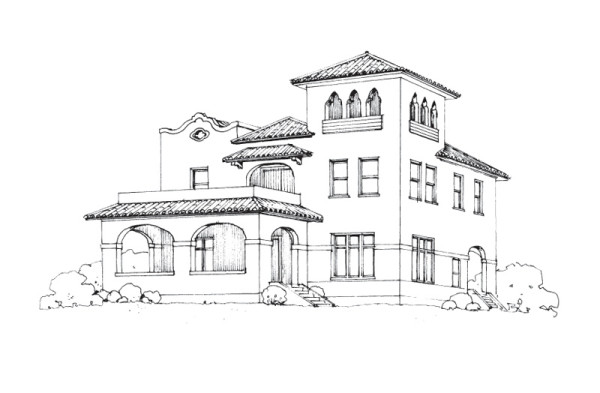
Casa del Herrero (1925) is a Spanish-style vision, complete with a Moorish garden. (Photo: Alex McLean)
Various Spanish revivals were the Hispanic counterpoint to New England’s Colonial Revival. The genre is certainly related to the greater Romantic Revival: In the East and Midwest, some older suburbs boast grand Georgians, homey English cottages, and a Mediterranean villa—all in the same or nearby neighborhoods. Building innovations like masonry veneer over wood frame and cement-based stucco had made romantic associations more affordable to build. Exposed timbers were not structural, but rather decoratively superimposed on modern wall systems. “Weathered” stucco was applied to look ancient.
The Mission Revival came first, one result of a preservation movement that had begun in the 1880s. Designers and builders adapted easily recognized motifs, most notably the curvaceous mission dormer or roof parapet, from Spanish–American adobe church buildings, Mission houses, most common in California and the Southwest, unfailingly have red tile roofs and walls of smooth stucco. The style lost momentum by 1920.
SPAIN AND BEYOND
Spanish Colonial is the most common of several related Mediterranean styles, and the dominant type in California, the Southwest, Texas, and to some extent in Florida. In the West, these houses were designed after the ranchos and other buildings of the colonial period. Motifs were, however, chosen from the rich, long history of Spanish architecture, and include Moorish, Byzantine, Gothic, and Renaissance elements. The Spanish Revival was in full swing at the turn of the century and through the 1930s.

(Illustration: Rob Leanna)
A few houses were built in Hispano–Moresque, Andalusian, and Egyptian variants, too. During the late 1920s, Art Deco shapes, colors, and motifs were woven into the architecture.
A few elements define interiors: arched openings between main rooms, rough plaster walls, and niches. Floors are often of waxed tile or wide oak boards; linoleum, though, was in its heyday. There’s a studied use of wrought iron for hardware and grilles, stair rails, or lighting fixtures. Neutral color in the plaster and, sometimes, a beamed or wooden ceiling conspired to produce monastic rooms.
But this was the Jazz Age, and the style a celebration of sunny climes, so vivid color was introduced through tile, painted accents, and imported fabrics. Reference to period photographs shows Spanish (or Mexican) Baroque or colonial pieces anchoring 20th-century Mission furniture along with the usual array of traditional upholstered pieces.
MISSION REVIVAL
In this early variant of Spanish-inspired revival architecture, look for red tiled roofs and smooth stucco accompanied by “old mission” parapets or dormers. Spanish Baroque ornament may decorate walls or door surrounds. The suggestion of a church bell tower appears on some examples, as in the illustration.







